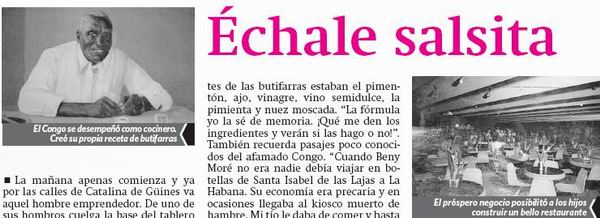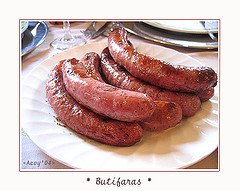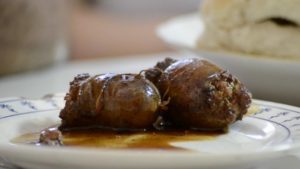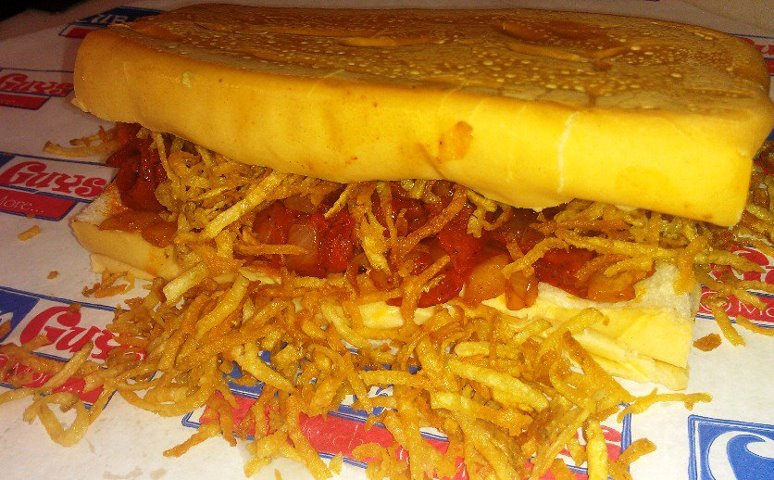 ‘EL CONGO’ Y SUS FAMOSAS BUTIFARRAS EN CATALINA DE GUINES, LA HABANA.
‘EL CONGO’ Y SUS FAMOSAS BUTIFARRAS EN CATALINA DE GUINES, LA HABANA.
Catalina de Güines es un poblado que se encuentra a unos 50 kilómetros de Ciudad de La Habana que en sus inicios su desarrollo dependía de sus tierras fértiles para el cultivo de la caña que abastecía a ingenios azucareros de la zona, del tabaco y del café. Luego en el año 1858 la llegada del ferrocarril y más tarde en la década del 30 la construcción de la Carretera Central, justo en su kilómetro 52, le dio un considerable desarrollo al pueblo.
En el período de construcción de la carretera central, importante vía de comunicación para el desarrollo de la isla, los pueblos y ciudades por los que pasaba la carretera, se veían beneficiados por las actividades comerciales y por el paso de viajeros, Catalina de Güines, fue uno de esos pueblos favorecidos.
Guillermo Armenteros, hombre de piel oscura que vestía impecablemente de blanco, que había sido esclavo, y que se ganaba la vida vendiendo todo tipo de fiambres y platos típicos de la cocina criolla, en su mayoría basados en la carne de puerco y conocido por el sobrenombre de El Congo desde su infancia, fue natural de esta zona, y provenía de una familia humilde dedicada al corte de caña. Era de mediana estatura, sencillo, jaranero, y dicen que bien parecido, y se calcula que haya nacido en la última década del siglo XIX.
Pero la especialidad que lo hizo famoso fue la butifarra, que preparaba con cerdo y una sazón muy propia, de forma que la hizo inigualable.
Las butifarras comenzaron a hacerse en 1955, y se vendían en las fiestas, frente al actual restaurante que mantiene el nombre de El Congo. Las butifarras, plato fruto de la cocina española en Catalina, con nuevos preparativos y condimentos en su confección, cambió su sabor y adquirió características muy personales y peculiares, por lo que logró alcanzar aceptación, gran popularidad y alto nivel de venta.
Al principio El Congo vendía el codiciado producto que estaba ubicado dentro de una cesta, la cual se colocaba sobre su cabeza, situado en sitios cercanos a los bailes y fiestas públicas, religiosas…
Durante sus gestiones de venta pregonaba la palabra: “¡salsa!”. Todos los comensales coincidían en que era un plato exquisito. El Congo progresó con el producto de sus ventas y entonces comenzó a vender las butifarras en una carretilla parecida a las que utilizan los granizaderos, donde expendía sus productos con pan o sin él.
Con posterioridad adquirió un quiosco transportado o portátil que podía trasladarlo con facilidad de un sitio a otro. El precio consistía en cinco centavos y se incrementaba a 10, si era acompañada de un pan; en caso de que este incluyera dos unidades, su costo era de 20 centavos.
Las unidades solas se vendían por decenas con su salsa. En 1957, al inaugurarse el restaurante, continuaron vendiéndose por esos valores y presentación, pero ahora, acompañadas de otras comidas.
Por allí pasaban los viajeros en ómnibus o en autos y se detenían a comer. El negocio de El Congo, prosperó y logró el éxito y la popularidad, y aquel modesto puesto se transformó en un restaurante, el lugar más importante del pueblo.
El Congo se convirtió en un lugar típico, como La Bodeguita del Medio, en La Habana, o La Casa de Pedro el Cojo, en Santiago de Cuba.
CONFECCIÓN DE LAS FAMOSAS BUTIFARRAS DEL CONGO.
En el proceso de fabricación de las butifarras intervenían cinco o seis personas, y cada una de ellas realizaba un trabajo específico: preparar la carne y los sazones, virar al revés los intestinos y lavarlos (luego se inflaban y ubicaban al sol), amasar y rellenar, amarrarlas y ponerlas al vapor de un fogón de carbón.
Se supone que los ingredientes, más o menos fueran: 50 por ciento de carne de puerco, 25 de empellas de cerdo y 25 de carne de res, y por supuesto, se les agregaba pimentón ‘El Potro’, ajo chileno, nuez moscada y sal. Las carnes se preparaban en forma de picadillo crudo, al que se le adicionaban especias y sazones.
Posteriormente, dicha masa era pasada a una habitación en la cual primero solo podía entrar El Congo, y después del fallecimiento de éste, su hija Guillermina. El proceso en aquel sitio constituía un secreto familiar, pues era donde se le daba el acabado a la masa, la que se depositaba, mediante un embudo, dentro de la llamada tripa, y se ubicaban sobre el fogón.
La salsa se preparaba aparte, con grasa, sazones y especias, sin puré de tomates. La ubicación del comercio, en sitio junto a la Carretera Central, contribuyó a engrandecer la fama de la butifarra, que en su momento era la principal del país.
Este producto se elaboró según la receta original del Congo hasta el año 1964. Ignacio Piñeiro y su Septeto se presentaron para actuar en un salón de baile denominado El Cañón, que existió en Catalina.
El Congo estaba pregonando su producto y le brindó butifarras a los músicos; le agradó tanto, que Ignacio Piñeiro prometió allí mismo componerle una canción, la cual fue estrenada en esa actividad. Esta pieza de la música popular contribuyó a incrementar la fama del apetecido producto.
El destacado y ya famoso boxeador Kid Gavilán, la actriz y cantante cubana Ninón Sevilla, quien desarrolló su carrera en México, y otras destacadas personas, también fueron conocidos visitantes del lugar.
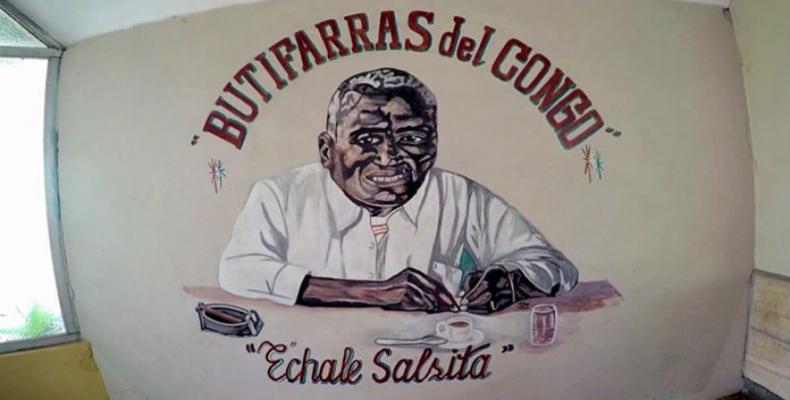 “THE CONGO’ AND HIS FAMOUS BUTIFARRAS EN CATALINA DE GUINES, HAVANA.
“THE CONGO’ AND HIS FAMOUS BUTIFARRAS EN CATALINA DE GUINES, HAVANA.
Catalina de Güines is a village located about 50 kilometers from Havana City, whose development depended on its fertile lands for the cultivation of cane that supplied sugar mills in the area, tobacco and coffee. Then in the year 1858 the arrival of the railroad and later in the decade of the 30 the construction of the Central Highway, right in its kilometer 52, gave a considerable development to the town.
In the period of construction of the central highway, an important means of communication for the development of the island, the towns and cities through which the road passed, benefited from commercial activities and the passage of travelers, Catalina de Güines, He was one of those favored people.
Guillermo Armenteros, dark-skinned man who dressed impeccably in white, who had been a slave, and who earned his living selling all kinds of cold meats and dishes typical of Creole cuisine, mostly based on pork and known by the nickname of the Congo from his childhood, was natural of this zone, and came from a humble family dedicated to the cut of cane. He was of medium height, simple, jaranero, and they say that good looking, and it is calculated that he was born in the last decade of the 19th century.
But the specialty that made him famous was the butifarra, which he prepared with pork and a very own seasoning, in a way that made it unique.
Butifarras began to be made in 1955, and were sold at parties, in front of the current restaurant that keeps the name of El Congo. The butifarras, dish fruit of the Spanish cuisine in Catalina, with new preparations and condiments in its confection, changed its flavor and acquired very personal and peculiar characteristics, for which it managed to reach acceptance, great popularity and high level of sale.
At first The Congo sold the coveted product that was located inside a basket, which was placed on his head, located in places near the dances and public, religious festivals …
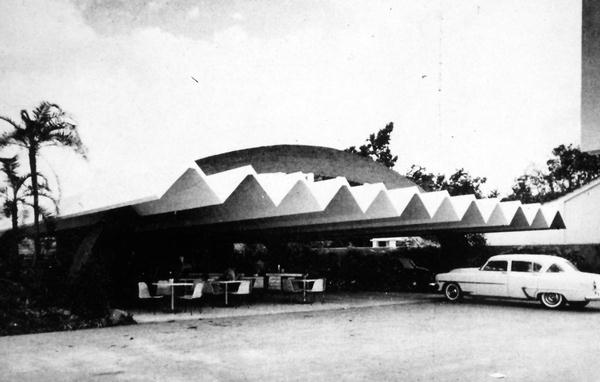
During his sales efforts he proclaimed the word: “salsa!”. All the diners agreed that it was an exquisite dish. The Congo progressed with the product of its sales and then began to sell the butifarras in a wheelbarrow similar to those used by the granizarderos, where they would sell their products with bread or without it.
Subsequently acquired a transported or portable kiosk that could move easily from one site to another. The price consisted of five cents and increased to 10 cents if it was accompanied by bread; if it included two units, its cost was 20 cents.
The single units were sold by the dozens with their sauce. In 1957, when the restaurant opened, they continued to sell themselves for those values and presentation, but now, accompanied by other meals.
Through there the passengers passed by bus or car and stopped to eat. The business of El Congo, prospered and achieved success and popularity, and that modest post was transformed into a restaurant, the most important place in town.
The Congo became a typical place, like La Bodeguita del Medio, in Havana, or La Casa de Pedro el Cojo, in Santiago de Cuba.
CONFECTION OF THE FAMOUS BUTIFARRAS DEL CONGO.
In the process of making the sausages five or six people were involved, and each of them did a specific job: preparing the meat and seasonings, turning upside down the intestines and washing them (then they were inflated and placed in the sun), kneading and fill, tie and steam them from a charcoal stove.
It is assumed that the ingredients, more or less were: 50 percent pork, 25 pork starters and 25 beef, and of course, they added paprika ‘El Potro’, Chilean garlic, nutmeg and Salt. The meats were prepared in the form of raw picadillo, to which spices and seasonings were added.
Later, this mass was passed to a room in which first he could only enter the Congo, and after the death of this one, his daughter Guillermina. The process in that place constituted a familiar secret, because it was where the mass was finished, the one that was deposited, by means of a funnel, inside the so-called gut, and they were placed on the stove.
The sauce was prepared separately, with fat, seasonings and spices, without tomato puree. The location of the commerce, in place next to the Central Highway, contributed to magnify the fame of the butifarra, that in its moment was the main one of the country.
This product was made according to the original recipe of the Congo until 1964. Ignacio Piñeiro and his Septeto appeared to perform in a dance hall called El Cañón, which existed in Catalina.
The Congo was trumpeting its product and gave the musicians sausages; It pleased him so much, that Ignacio Piñeiro promised right there to compose a song, which was premiered in that activity. This piece of popular music contributed to increase the fame of the desired product.
The outstanding and already famous boxer Kid Gavilán, the Cuban actress and singer Ninón Sevilla, who developed his career in Mexico, and other prominent people, also attended the seat.
Agencies/ Wiki/ EcuRed/ Maria Calvo/ Extractos/ Internet Photos/ YouTube/ Arnoldo Varona/ www.TheCubanhistory.com
THE CUBAN HISTORY, HOLLYWOOD.



